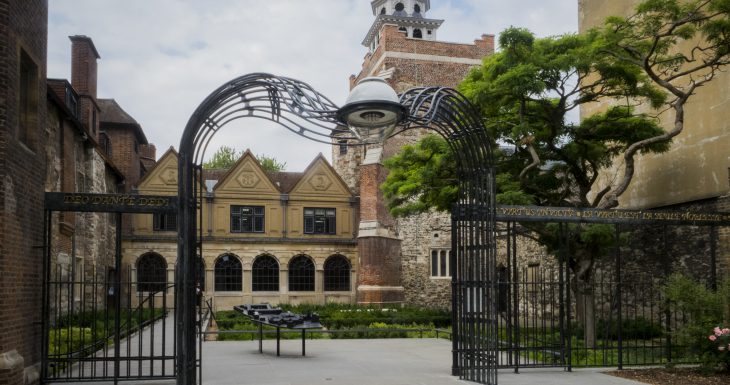The Charterhouse
A historic complex of buildings in Clerkenwell, London, dating back to the 14th century.
The Charterhouse, Charterhouse Square, Clerkenwell, London EC1M 6AN

Entrance to the museum, Chapel and shop is on Charterhouse Square and is step-free and wheelchair accessible. The public areas of the reception, museum display, Chapel, learning centre and cloakroom facilities are fully accessible for wheelchair users and people with limited mobility. There is a lift in the reception area which can be used for visitors to the Great Chamber; please let us know in advance if you require ramp access for a Saturday tour but weekday tours do not require advance notice.
– There are accessible toilet and baby changing facilities but please be aware that there is limited buggy parking.
– The nearest Changing Places toilets are at the Barbican Centre.
– We have a small number of disabled parking spaces for Blue and Orange Badge holders; please call us in advance to book a space.
– We do not have a dedicated quiet space apart from the Chapel, but you are welcome to get in touch with us before your visit to discuss your needs.
The Charterhouse is a contemporary almshouse and a fascinating heritage site in the heart of London. Our residents, known as ‘Brothers’ although no longer exclusively men, are at the heart of our community and call the Charterhouse their home. They are beneficiaries of a charity established in 1611 by Thomas Sutton, the spirit of which is still enacted today.
The history of the Charterhouse however dates to the era of the Black Death in 1348, when land which is now Charterhouse Square was leased as an emergency cemetery for victims of the plague. Sir Walter Manny, a Baron and former soldier who came to the court of Edward III from Hainault, now in France, paid for the lease and later the building of a Chapel nearby to pray for their souls. Michael Northburgh, the Bishop of London, had the idea of founding a Carthusian monastery, known as a Charterhouse, in London, having been impressed by one he visited in Paris. Sir Walter Manny was also involved in sponsoring the monastery, and after Northburgh’s death he went on to found what became the impressive and well-respected London Charterhouse in 1371 on land adjacent to the emergency cemetery.
The monastery thrived for many years, but with the Reformation under Henry VIII, the Prior and 15 monks were martyred and the Charterhouse was dissolved and confiscated by the Crown. For a while it was used as a store, including for Henry VIII’s tents, and lodgings. In 1545, Sir Edward North the new owner of the Charterhouse began building a grand Tudor mansion using and adapting the buildings of the former monastery. The mansion passed through the ownership of several wealthy noblemen most notably Thomas Howard, the 4th Duke of Norfolk. Amongst the many elite guests entertained during this period were Elizabeth I, who stayed just before her coronation in 1558 and met her first Privy Council in the Great Chamber, and James I (James VI of Scotland) who also stayed prior to his coronation and created 130 new knights in the Great Chamber.
In 1611, Thomas Sutton bought the Charterhouse and proceeded to establish the foundation that still bears his name which was in its day the wealthiest charity in Europe. Sutton had been Master of the Ordnance in the North, and increased his fortune through leasing land he owned for coal mining and lending money to the aristocracy. He had no heirs and wished to use the Charterhouse to set up a ‘hospital’, or an almshouse as we would now call it, for up to 80 gentlemen: “either decrepit or old captaynes either at sea or at land, maimed or disabled soldiers, merchants fallen on hard times, those ruined by shipwreck of other calamity” and a school for 40 “poor boys”. The school grew and evolved and eventually left the site and moved to Godalming in Surrey in 1872, becoming the Charterhouse school known today. Meanwhile the almshouse remains on the site, and while the residents still eat communally in the Great Hall as they would have done in the 17th century, much has changed in the intervening years.
Further facts:
• Thomas More studied at the Charterhouse when it was a Carthusian monastery and considered joining the order.
• From James I onwards, the monarch has always been a royal Governor of the Charterhouse
• Historic Governors include Oliver Cromwell, the first Duke of Wellington, Judge Jeffries, John Dunne, the Duke of Monmouth and Robert Peel.
• Cleric and Theologian John Wesley and Vanity Fair author William Makepeace Thackeray were pupils of the school when it was based at the Charterhouse.
• The Charterhouse school team played football in the long and narrow Norfolk Cloister, and this is said to have contributed to the creation of several Football Association rules, including the off-side rule.
Entrance to the museum, Chapel and shop is on Charterhouse Square and is step-free and wheelchair accessible. The public areas of the reception, museum display, Chapel, learning centre and cloakroom facilities are fully accessible for wheelchair users and people with limited mobility. There is a lift in the reception area which can be used for visitors to the Great Chamber; please let us know in advance if you require ramp access for a Saturday tour but weekday tours do not require advance notice.
– There are accessible toilet and baby changing facilities but please be aware that there is limited buggy parking.
– The nearest Changing Places toilets are at the Barbican Centre.
– We have a small number of disabled parking spaces for Blue and Orange Badge holders; please call us in advance to book a space.
– We do not have a dedicated quiet space apart from the Chapel, but you are welcome to get in touch with us before your visit to discuss your needs.
